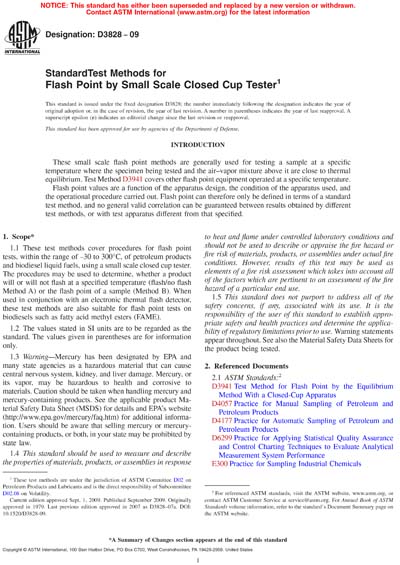Historical
ASTM D3828-09
Standard Test Methods for Flash Point by Small Scale Closed Cup Tester
1.1 These test methods cover procedures for flash point tests, within the range of –30 to 300°C, of petroleum products and biodiesel liquid fuels, using a small scale closed cup tester. The procedures may be used to determine, whether a product will or will not flash at a specified temperature (flash/no flash Method A) or the flash point of a sample (Method B). When used in conjunction with an electronic thermal flash detector, these test methods are also suitable for flash point tests on biodiesels such as fatty acid methyl esters (FAME).
1.2 The values stated in SI units are to be regarded as the standard. The values given in parentheses are for information only.
1.3 Warning—Mercury has been designated by EPA and many state agencies as a hazardous material that can cause central nervous system, kidney, and liver damage. Mercury, or its vapor, may be hazardous to health and corrosive to materials. Caution should be taken when handling mercury and mercury-containing products. See the applicable product Material Safety Data Sheet (MSDS) for details and EPA’s website (http://www.epa.gov/mercury/faq.htm) for additional information. Users should be aware that selling mercury or mercury-containing products, or both, in your state may be prohibited by state law.
1.4 This standard should be used to measure and describe the properties of materials, products, or assemblies in response to heat and flame under controlled laboratory conditions and should not be used to describe or appraise the fire hazard or fire risk of materials, products, or assemblies under actual fire conditions. However, results of this test may be used as elements of a fire risk assessment which takes into account all of the factors which are pertinent to an assessment of the fire hazard of a particular end use.
1.5 This standard does not purport to address all of the safety concerns, if any, associated with its use. It is the responsibility of the user of this standard to establish appropriate safety and health practices and determine the applicability of regulatory limitations prior to use. Warning statements appear throughout. See also the Material Safety Data Sheets for the product being tested.
ASTM International [astm]

